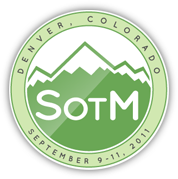Spatial Data Access Tool: Enabling Visualization of and Access to Geospatial Data using OGC Standards and Open Source Software
The Spatial Data Access Tool (SDAT, http://webmap.ornl.gov/wcsdown) developed at the Oak Ridge National Laboratory Distributed Active Archive Center (ORNL DAAC) and the Modeling and Synthesis Thematic Data Center (MAST-DC), both NASA-funded projects, provides visualization and access to a variety of biophysical, vegetation, elevation, ecosystem, climate, soil, and model data sets using Open Geospatial Consortium (OGC) services and open source software.
The SDAT is built on a 3-tier architecture: data, logic, and presentation tiers. The data tier includes PostgreSQL-based ArcSDE spatial databases and regular file systems storing geospatial data in non-proprietary file formats, including GeoTIFF and netCDF. The backbone of the logic tier is a cluster of OGC Web Map Services (WMS) and Web Coverage Services (WCS), which provide on-demand visualization and access to geospatial data stored in the data tier in different spatial/temporal extent, projection, resolution, and data format. The WMS and WCS are built on top of MapServer and enhanced with automatic mapfile generation to ease the ingest of new data into these services. The main component of the presentation tier is a Web application client that utilizes the services from the logic tier. This Web application provides features that allow users to conveniently search for data, view both dataset-level and granule-level metadata, visualize data, and access data. The presentation tier provides a WMS-based interactive map widget, which is built with OpenLayers that allows users to visualize geospatial data. Another component of the presentation tier is an OGC Keyhole Markup Language (KML) link to visualize geospatial data in Google Earth or any KML-compatible client.
Statistics shows SDAT is a convenient tool for environmental science researchers and its usage has increased significantly since its launch in 2009. The 3-tier architecture together with the open source and standards based feature makes SDAT a flexible, easy to use, and widely used tool.
Dr. Yaxing Wei is currently a post-doctoral research associate in Environmental Sciences Division at ORNL. His research interests include advanced geospatial information management, visualization and delivery; OGC standards and interoperability.











